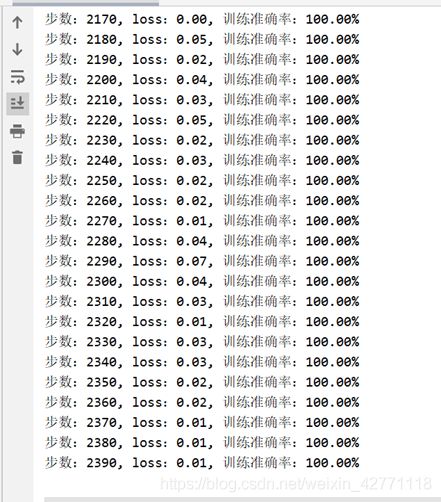基于TensorFlow实现的CNN神经网络 花卉识别系统Demo
基于TensorFlow实现的CNN神经网络 花卉识别系统Demo
- Demo展示
-
- 登录与注册
- 主页面
- 模型训练
- 识别
- 神经网络
- 训练
- Demo下载
Demo展示
登录与注册
主页面
模型训练
识别
神经网络
定义CNN网络结构
卷积神经网络,卷积加池化2,全连接2,softmax分类
关键代码:
# 定义函数infence,定义CNN网络结构
# 卷积神经网络,卷积加池化*2,全连接*2,softmax分类
# 卷积层1
def inference(images, batch_size, n_classes):
with tf.variable_scope('conv1') as scope:
weights = tf.Variable(tf.truncated_normal(shape=[3, 3, 3, 64], stddev=1.0, dtype=tf.float32),
name='weights', dtype=tf.float32)
biases = tf.Variable(tf.constant(value=0.1, dtype=tf.float32, shape=[64]),
name='biases', dtype=tf.float32)
conv = tf.nn.conv2d(images, weights, strides=[1, 1, 1, 1], padding='SAME')
pre_activation = tf.nn.bias_add(conv, biases)
conv1 = tf.nn.relu(pre_activation, name=scope.name)
# 池化层1
# 3x3最大池化,步长strides为2,池化后执行lrn()操作,局部响应归一化,对训练有利。
with tf.variable_scope('pooling1_lrn') as scope:
pool1 = tf.nn.max_pool(conv1, ksize=[1, 3, 3, 1], strides=[1, 2, 2, 1], padding='SAME', name='pooling1')
norm1 = tf.nn.lrn(pool1, depth_radius=4, bias=1.0, alpha=0.001 / 9.0, beta=0.75, name='norm1')
# 卷积层2
# 16个3x3的卷积核(16通道),padding=’SAME’,表示padding后卷积的图与原图尺寸一致,激活函数relu()
with tf.variable_scope('conv2') as scope:
weights = tf.Variable(tf.truncated_normal(shape=[3, 3, 64, 16], stddev=0.1, dtype=tf.float32),
name='weights', dtype=tf.float32)
biases = tf.Variable(tf.constant(value=0.1, dtype=tf.float32, shape=[16]),
name='biases', dtype=tf.float32)
conv = tf.nn.conv2d(norm1, weights, strides=[1, 1, 1, 1], padding='SAME')
pre_activation = tf.nn.bias_add(conv, biases)
conv2 = tf.nn.relu(pre_activation, name='conv2')
# 池化层2
# 3x3最大池化,步长strides为2,池化后执行lrn()操作,
# pool2 and norm2
with tf.variable_scope('pooling2_lrn') as scope:
norm2 = tf.nn.lrn(conv2, depth_radius=4, bias=1.0, alpha=0.001 / 9.0, beta=0.75, name='norm2')
pool2 = tf.nn.max_pool(norm2, ksize=[1, 3, 3, 1], strides=[1, 1, 1, 1], padding='SAME', name='pooling2')
# 全连接层3
# 128个神经元,将之前pool层的输出reshape成一行,激活函数relu()
with tf.variable_scope('local3') as scope:
reshape = tf.reshape(pool2, shape=[batch_size, -1])
dim = reshape.get_shape()[1].value
weights = tf.Variable(tf.truncated_normal(shape=[dim, 128], stddev=0.005, dtype=tf.float32),
name='weights', dtype=tf.float32)
biases = tf.Variable(tf.constant(value=0.1, dtype=tf.float32, shape=[128]),
name='biases', dtype=tf.float32)
local3 = tf.nn.relu(tf.matmul(reshape, weights) + biases, name=scope.name)
# 全连接层4
# 128个神经元,激活函数relu()
with tf.variable_scope('local4') as scope:
weights = tf.Variable(tf.truncated_normal(shape=[128, 128], stddev=0.005, dtype=tf.float32),
name='weights', dtype=tf.float32)
biases = tf.Variable(tf.constant(value=0.1, dtype=tf.float32, shape=[128]),
name='biases', dtype=tf.float32)
local4 = tf.nn.relu(tf.matmul(local3, weights) + biases, name='local4')
# dropout层
# with tf.variable_scope('dropout') as scope:
# drop_out = tf.nn.dropout(local4, 0.8)
# Softmax回归层
# 将前面的FC层输出,做一个线性回归,计算出每一类的得分
with tf.variable_scope('softmax_linear') as scope:
weights = tf.Variable(tf.truncated_normal(shape=[128, n_classes], stddev=0.005, dtype=tf.float32),
name='softmax_linear', dtype=tf.float32)
biases = tf.Variable(tf.constant(value=0.1, dtype=tf.float32, shape=[n_classes]),
name='biases', dtype=tf.float32)
softmax_linear = tf.add(tf.matmul(local4, weights), biases, name='softmax_linear')
return softmax_linear
# -----------------------------------------------------------------------------
# loss计算
# 传入参数:logits,网络计算输出值。labels,真实值,在这里是0或者1
# 返回参数:loss,损失值
def losses(logits, labels):
with tf.variable_scope('loss') as scope:
cross_entropy = tf.nn.sparse_softmax_cross_entropy_with_logits(logits=logits, labels=labels, name='xentropy_per_example')
loss = tf.reduce_mean(cross_entropy, name='loss')
tf.summary.scalar(scope.name + '/loss', loss)
return loss
# --------------------------------------------------------------------------
# loss损失值优化
# 输入参数:loss。learning_rate,学习速率。
# 返回参数:train_op,训练op,这个参数要输入sess.run中让模型去训练。
def trainning(loss, learning_rate):
with tf.name_scope('optimizer'):
optimizer = tf.train.AdamOptimizer(learning_rate=learning_rate)
global_step = tf.Variable(0, name='global_step', trainable=False)
train_op = optimizer.minimize(loss, global_step=global_step)
return train_op
# -----------------------------------------------------------------------
# 评价/准确率计算
# 输入参数:logits,网络计算值。labels,标签,也就是真实值,在这里是0或者1。
# 返回参数:accuracy,当前step的平均准确率,也就是在这些batch中多少张图片被正确分类了。
def evaluation(logits, labels):
with tf.variable_scope('accuracy') as scope:
correct = tf.nn.in_top_k(logits, labels, 1)
correct = tf.cast(correct, tf.float16)
accuracy = tf.reduce_mean(correct)
tf.summary.scalar(scope.name + '/accuracy', accuracy)
return accuracy
训练
关键代码:
class Train:
path, train_dir, logs_train_dir = None, None, None
def __init__(self):
self.path = os.path.dirname(os.path.dirname(os.path.realpath(__file__)))
self.train_dir = self.path + '/input_data' # 训练样本的读入路径
self.logs_train_dir = self.path + '/save' # logs存储路径
def train(self, BATCH_SIZE=20, MAX_STEP=1000, learning_rate=0.0001):
# 变量声明
N_CLASSES = 4 # 四种花类型
IMG_W = 64 # resize图像,太大的话训练时间久
IMG_H = 64
CAPACITY = 200
# 获取批次batch
# train, train_label = input_data.get_files(train_dir)
train, train_label, val, val_label = input_data.get_files(self.train_dir, 0.3)
# 训练数据及标签
train_batch, train_label_batch = input_data.get_batch(train, train_label, IMG_W, IMG_H, BATCH_SIZE, CAPACITY)
# 测试数据及标签
val_batch, val_label_batch = input_data.get_batch(val, val_label, IMG_W, IMG_H, BATCH_SIZE, CAPACITY)
# 训练操作定义
train_logits = model.inference(train_batch, BATCH_SIZE, N_CLASSES)
train_loss = model.losses(train_logits, train_label_batch)
train_op = model.trainning(train_loss, learning_rate)
train_acc = model.evaluation(train_logits, train_label_batch)
# 测试操作定义
test_logits = model.inference(val_batch, BATCH_SIZE, N_CLASSES)
test_loss = model.losses(test_logits, val_label_batch)
test_acc = model.evaluation(test_logits, val_label_batch)
# 这个是log汇总记录
summary_op = tf.summary.merge_all()
# 产生一个会话
sess = tf.Session()
# 产生一个writer来写log文件
train_writer = tf.summary.FileWriter(self.logs_train_dir, sess.graph)
# 产生一个saver来存储训练好的模型
saver = tf.train.Saver()
# 所有节点初始化
sess.run(tf.initialize_all_variables())
# 队列监控
coord = tf.train.Coordinator()
threads = tf.train.start_queue_runners(sess=sess, coord=coord)
# 进行batch的训练
try:
print('批次为:{},步数为:{},学习率为:{}'.format(BATCH_SIZE, MAX_STEP, learning_rate))
# 执行MAX_STEP步的训练,一步一个batch
for step in np.arange(MAX_STEP + 1):
if coord.should_stop():
break
_, tra_loss, tra_acc = sess.run([train_op, train_loss, train_acc])
# 每隔50步打印一次当前的loss以及acc,同时记录log,写入writer
if step % 10 == 0:
print('步数:%d, loss:%.2f, 训练准确率:%.2f%%' % (step, tra_loss, tra_acc * 100.0))
summary_str = sess.run(summary_op)
train_writer.add_summary(summary_str, step)
# 每隔100步,保存一次训练好的模型
if (step) == MAX_STEP:
checkpoint_path = os.path.join(self.logs_train_dir, 'model.ckpt')
saver.save(sess, checkpoint_path, global_step=step)
except tf.errors.OutOfRangeError:
print('到达训练上限,训练完成')
finally:
coord.request_stop()
if __name__ == '__main__':
Train().train()
Demo下载
大家喜欢的话,希望可以star一下,谢谢。
https://github.com/JJJiangYH/Flower-Distinguish








